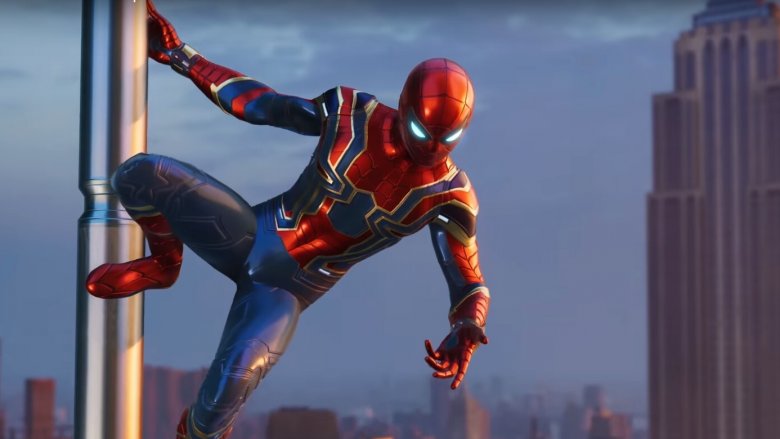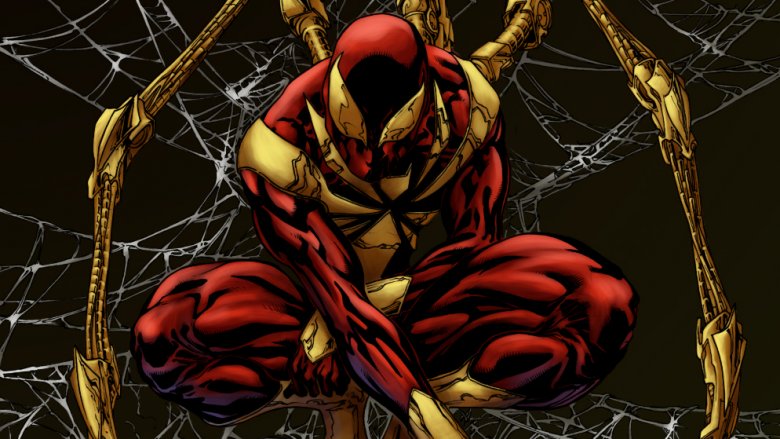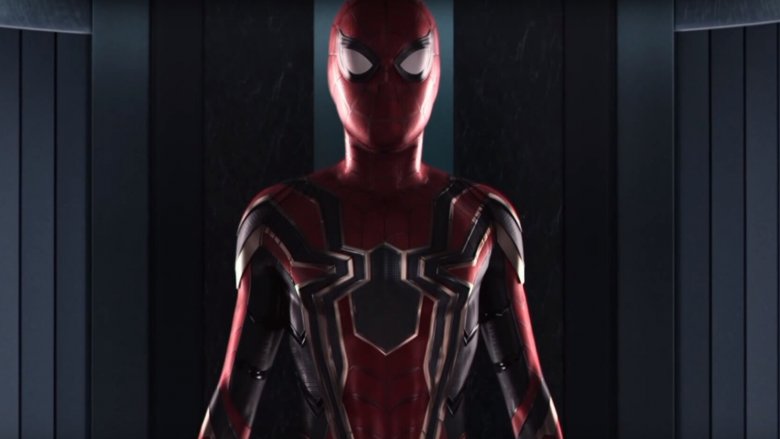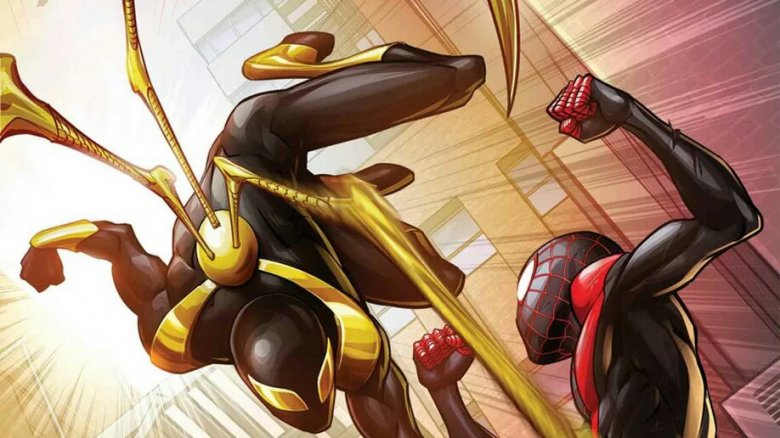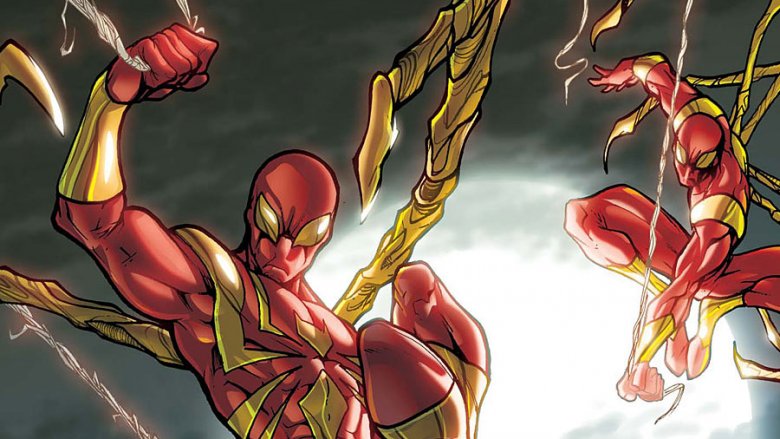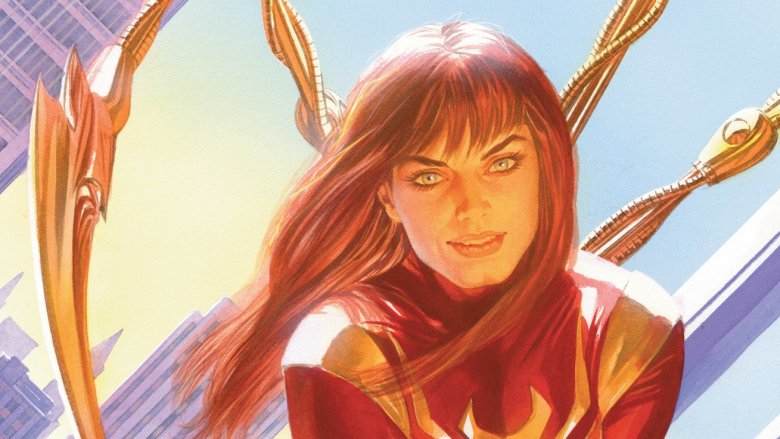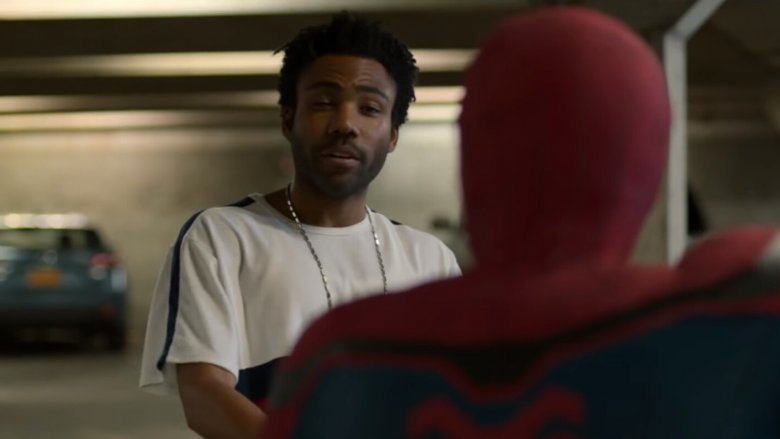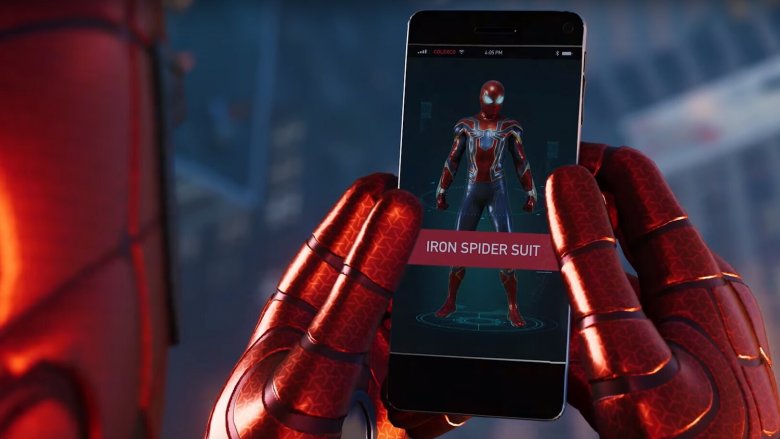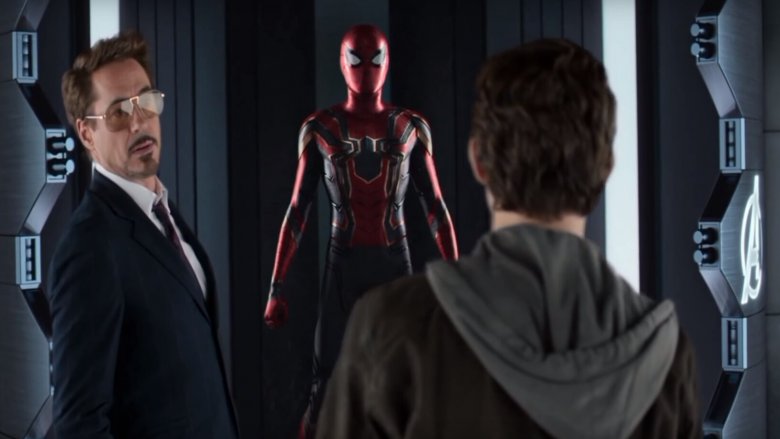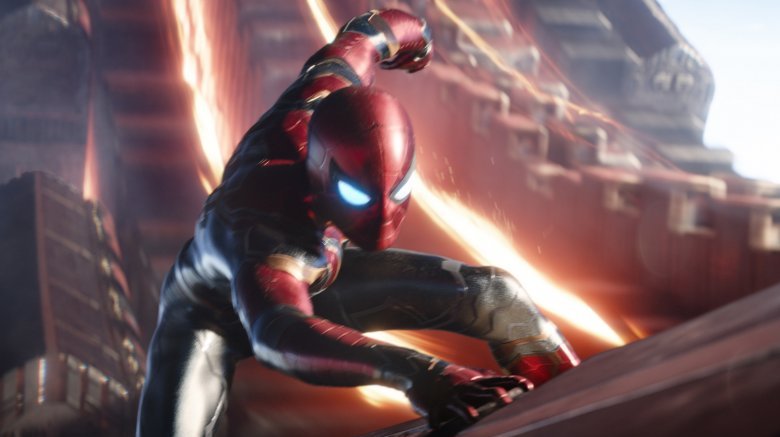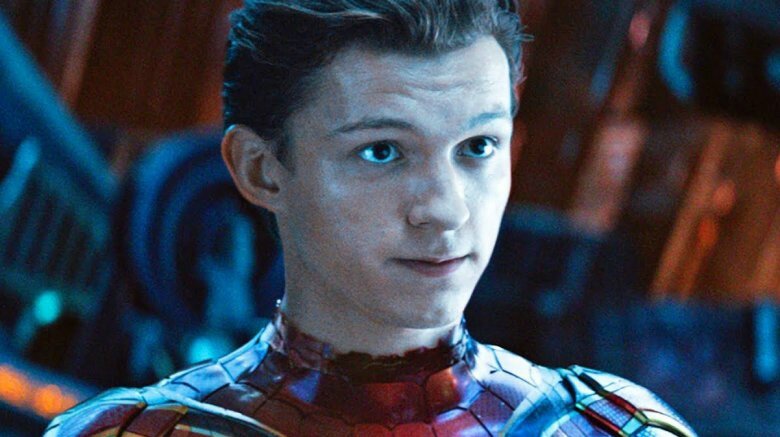The Untold Truth Of Spider-Man's Iron Spider Suit
When Spider-Man entered the Marvel Cinematic Universe in Captain America: Civil War, it was Tony Stark who gave Peter Parker the technology he needed to live up to his superpowered potential — a creative decision that was not without controversy among fans. Some worried that a reliance on Iron Man, whose presence already loomed over much of the MCU, would undermine the strength of one of comics history's most beloved characters.
Fortunately, Spider-Man: Homecoming was a crowd-pleaser, and it allowed Peter to come out from under Iron Man's high-tech wing and realize that it was his heart, not his suit, that made him a hero. But then came Avengers: Infinity War, requiring Spider-Man to journey into space. He needed a new suit, and Stark was there again to provide a significant new upgrade: the Iron Spider.
But the Iron Spider is more than just a spacesuit. It's a costume with a dense comic book pedigree that represents some important twists and turns in the life of Spider-Man, and bringing it to the screen required more than some flashy fabric. Join us as we explore the tangled web of the Iron Spider.
Spider-Man was dead to begin with
The Civil War movie may have been Spidey's introduction to the Marvel Cinematic Universe, but the story's comic book namesake marked a pretty important turning point for the webhead, too. In fact, just before the Civil War event began, Peter Parker was dead. Having been killed by the vampire Morlun and then mysteriously reborn in a story arc titled "The Other," Parker was going through something of an identity crisis, to put it mildly.
As the entire Marvel Universe trudged through "The Road to Civil War," Tony Stark prepared a new high-tech armor for Spider-Man, hoping to protect his ally from another fatal encounter. Enter: the Iron Spider. Parker was immediately impressed by the upgrade, but wondered why Stark had gone to so much trouble for him. The truth was that Stark hoped he could count on Spider-Man's help in the coming conflict with Captain America over the Superhuman Registration Act.
More than meets the eye
Far from just being an extra-strength armor, the Iron Spider suit comes equipped with a variety of features Spider-Man didn't have before. Essentially combining the strengths of both Spider-Man and Iron Man, a cutting-edge blend of nano-technology and onboard computer systems makes the Iron Spider a whole new kind of hero. The suit even generates webbing on the go, ensuring that Parker will never run out of the sticky stuff (not that the comics had a history of being concerned with realistic quantities to begin with).
With 17 layers of functionality, the Iron Spider suit lends itself to many of the very specific far-out situations a Marvel superhero might find themselves in. Enhanced gliding, climate control, chemical filtering, speed-of-thought communication, and digital camouflage supplement Spidey's already heightened senses and powers. Much like Iron Man, the suit is powered by a self-sustaining chestpiece, and the mask provides its wearer with an interconnected heads-up display. The whole thing is topped off with a layer of diamond nitrile overcoat, providing near-impenetrable defense without compromising the wall-crawler's agility.
Seven or eight arms to hold you
The most distinctive design element of the Iron Spider suit is a set of robotic appendages that deploy from its back. These long, powerful, spindly arms, or "waldoes," put even more spider in Spider-Man by allowing him to scuttle more nimbly around walls. Activated via neural command from the wearer of the suit, the waldoes deploy almost instantly, at a rate of 90 inches per second. In addition to their arachnid climbing and crawling capabilities, they're equipped with various sensors and cameras that allow Spider-Man to detect minuscule vibrations and see around corners.
Curiously, the original iteration of the Iron Spider came equipped with only three waldoes, stretching out in a Y formation above and below the suit. Some alternate versions, including the one seen onscreen in Infinity War, would expand the number of legs to four, with an even two on each side. This arrangement really makes the most sense, when you factor in the four human limbs of Peter Parker and bring the total to a more spider-like eight.
Crimson clones
As it did for so many others, the Civil War comics event led Peter Parker to nothing but misery. While the conflict over the Superhuman Registration Act grew more bitter and violent, Tony Stark became increasingly paranoid. Parker soon realized that Stark had secretly equipped the Iron Spider suit with features designed to spy on and potentially subdue him. This, coupled with his first good look at the government's treatment of superhumans in custody, led him to switch sides and abandon the suit.
But it wasn't long before the Iron Spider found a new home...or three. With the original Spider-Man an outlaw on the run, Stark gave upgraded versions of the armor to the Scarlet Spiders. Tasked with replacing Parker, this trio of clones (Spider-Man's comic history is just crawling with clones) was created from the DNA of the fallen hero known as MVP. A furious Peter Parker took on the Spiders, but ended up rescuing them from an attack by the Vulturions. The grateful replacements then helped him evade capture.
Swingin' with Mary Jane
Mary Jane Watson has been through a lot. In her 50-year comics history, her relationship with Peter Parker has been constantly on-again/off-again, so much so that their eventual marriage was erased from reality by a deal with Mephisto. Marvel has a bit of an unfortunate tendency to create drama for MJ by having her get romantically involved with yet another man. When she joined the supporting cast of Invincible Iron Man, the company played up the potential for romantic tension between her and Stark.
One of the more interesting results of Mary Jane's stint with Stark Enterprises came when both Spider-Man and Iron Man were taken captive by the villain known as the Regent. A quick-thinking MJ dug through Avengers Tower storage and found the Iron Spider suit. Deftly donning it, she swung into action and rescued the two men. She even got to fly solo on the issue's cover, which boldly declared her "The New Iron Spider?!"
Ultimate uncle
Despite that interrobang-tinged cover proclamation, it would be the last comic issue to date with Mary Jane as the Iron Spider. The suit was next seen as part of a world-shattering event. When the Ultimate Universe crossed over with the Marvel Prime Universe, the Ultimate Spider-Man, Miles Morales, came face-to-face with his own version of Spidey's collective of nemeses, the Sinister Six. This iteration of the evil legion consisted of Hobgoblin, Spot, Bombshell, Sandman, Electro, and the Iron Spider.
The identity of the man in the iron mask remained secret until a shocking revelation: it was Miles' uncle, Aaron Davis, known in the Ultimate Universe as the Prowler. This was surprising for a number of reasons, not the least of which being that Davis was dead before the universes merged. Miles attempted to turn his uncle away from this life of crime, but the Iron Spider fell in battle, seemingly to his death. He did return, however, to tell his nephew he was right.
The MCU has its own version of the Prowler, even if it seems unlikely that he'll end up as the Iron Spider. In Spider-Man: Homecoming, Donald Glover portrayed a version of the character, attempting to buy black market weapons technology (much like how he acquired the armor in the comics). He eventually helps Spider-Man because he wants the neighborhood to be safe for his nephew. A deleted scene even had him call Miles by name over the phone.
Alternate realities
The Iron Spider's unique capabilities and distinctive look have made it a prime candidate for adaptation to other Spider-Man media. In the Ultimate Spider-Man animated series, the armor has passed from Peter Parker to Amadeus Cho, a young genius who, in the prime comics universe, eventually became the Hulk. The cartoon has also featured a Hulkbuster variant on the Iron Spider.
Video games, a natural venue for vast variations on superhero costumes to serve as unlockable content, have also made use of the Iron Spider. The armor is featured as a playable costume in both Marvel: Ultimate Alliance games, the Spider-Man outings Shattered Dimensions and Edge of Time, and Ultimate Marvel vs. Capcom 3. The mobile game Avengers Academy allows Mary Jane to once again become the Iron Spider. With the suit's profile higher than ever, the Spider-Man game for PlayStation 4 features a version of the Iron Spider based on its movie appearance, as revealed in a trailer released hot on the heels of Infinity War.
Cinematic parallels
Of course, the highest-profile appearance of the Iron Spider in another medium is its arrival in the Marvel Cinematic Universe. Since Spider-Man's new movie origins are so closely linked with Tony Stark, it's no surprise that the films wasted no time in introducing the armor. Stark, finally convinced that Peter Parker was a hero in his own right, offered up the Iron Spider at the end of Spider-Man: Homecoming. With a room full of reporters waiting for Stark's announcement of the newest Avengers recruit, Peter walked away, choosing to remain a "friendly neighborhood Spider-Man."
More than just a nod to the comics, this moment represents a turning point for the whole MCU. A press conference to announce the arrival of a new superhero is a perfect parallel to the ending of the original Iron Man, the franchise's origin. Peter's decision to eschew Stark's brand of spotlight-loving swagger signals the spirit of a new generation ready to take up the torch as the movies move into their second decade.
Too fantastical to exist
Of course, it didn't take long for Peter to end up in the Iron Spider suit anyway, though it wasn't exactly his choice. Clinging to the side of Ebony Maw's Titan-bound spaceship, he nearly blacked out as the air grew ever thinner, until Stark came to his rescue by deploying the life-sustaining armor to catch him. The Iron Spider would be Peter Parker's outfit for the rest of Infinity War. You might say it was the last suit he would ever need.
But there's more to the onscreen appearance of the Iron Spider than meets the eye. Actually, it might be more accurate to say there's less. While most of the MCU's costumes are at least mostly practical (even the heavy CG enhancements to Iron Man are built on a base of real pieces), the Iron Spider's blend of sleekness and complexity led the filmmakers to keep it entirely in the realm of visual effects.
"It's too fantastical to exist in real life," explained spider-star Tom Holland. Spending the entirety of Infinity War's production in motion-capture attire gave Holland a self-consciousness very befitting of Spider-Man. While promoting the movie, he has playfully griped about the experience of standing alongside his A-list co-stars wearing "pajamas with balls on them that light up."
Spidery secrets
Though fans were thrilled by their first glimpse of the Iron Spider in action in Infinity War's trailers, Marvel's marketing department was determined to save some surprises for opening night. The suit's most distinctive feature, its four long, mechanical legs, make for a dynamic visual when they're first revealed. Later, they play a key role in one of the movie's most engaging action scenes, as Peter scuttles to the rescue of his many new friends during the fight with Thanos on Titan.
To maintain the fun of the legs' first sudden deployment, Marvel took several measures to deny fans an early peek. While new Avengers toys and merchandise began flooding the market months before Infinity War dropped, Spider-Man figures highlighting the arachnid appendages were withheld until closer to the film's release (despite an early leak or two). The ever-prolific Funko made a special addition to their Infinity War line of vinyl Pop figures to include a leg-bearing Iron Spider and the "Stonekeeper," another character whose true face would have been a spoiler. Some shots in the trailers are even missing the legs where they would be in the finished film.
